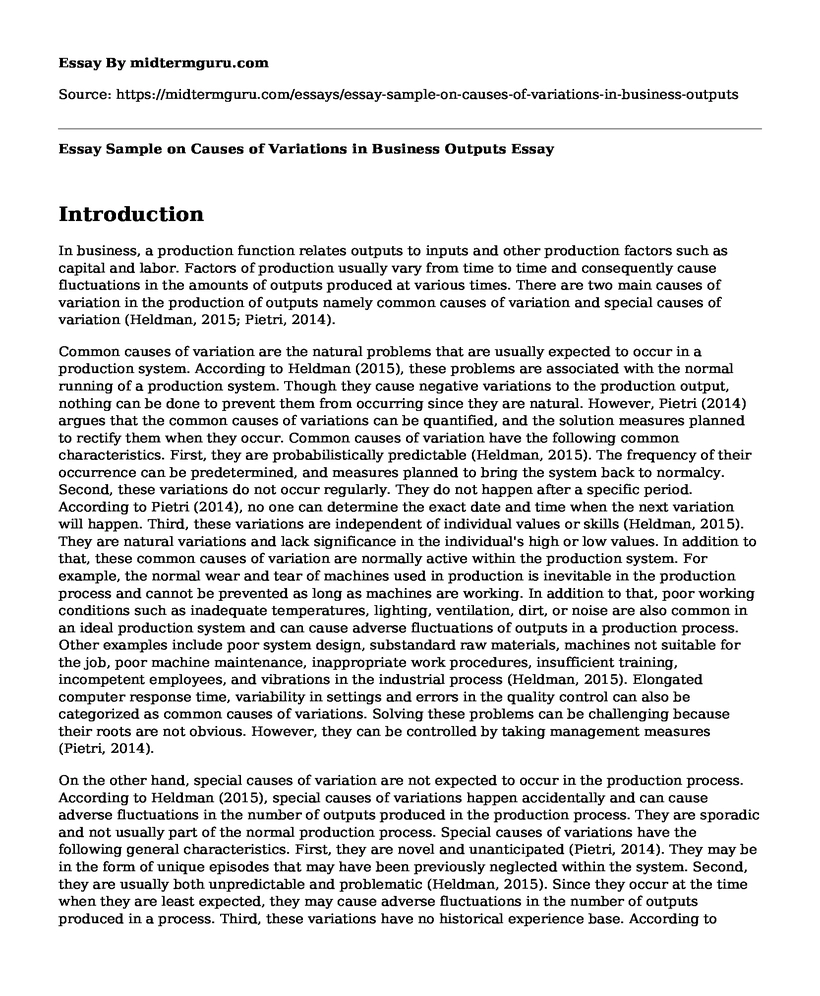Introduction
In business, a production function relates outputs to inputs and other production factors such as capital and labor. Factors of production usually vary from time to time and consequently cause fluctuations in the amounts of outputs produced at various times. There are two main causes of variation in the production of outputs namely common causes of variation and special causes of variation (Heldman, 2015; Pietri, 2014).
Common causes of variation are the natural problems that are usually expected to occur in a production system. According to Heldman (2015), these problems are associated with the normal running of a production system. Though they cause negative variations to the production output, nothing can be done to prevent them from occurring since they are natural. However, Pietri (2014) argues that the common causes of variations can be quantified, and the solution measures planned to rectify them when they occur. Common causes of variation have the following common characteristics. First, they are probabilistically predictable (Heldman, 2015). The frequency of their occurrence can be predetermined, and measures planned to bring the system back to normalcy. Second, these variations do not occur regularly. They do not happen after a specific period. According to Pietri (2014), no one can determine the exact date and time when the next variation will happen. Third, these variations are independent of individual values or skills (Heldman, 2015). They are natural variations and lack significance in the individual's high or low values. In addition to that, these common causes of variation are normally active within the production system. For example, the normal wear and tear of machines used in production is inevitable in the production process and cannot be prevented as long as machines are working. In addition to that, poor working conditions such as inadequate temperatures, lighting, ventilation, dirt, or noise are also common in an ideal production system and can cause adverse fluctuations of outputs in a production process. Other examples include poor system design, substandard raw materials, machines not suitable for the job, poor machine maintenance, inappropriate work procedures, insufficient training, incompetent employees, and vibrations in the industrial process (Heldman, 2015). Elongated computer response time, variability in settings and errors in the quality control can also be categorized as common causes of variations. Solving these problems can be challenging because their roots are not obvious. However, they can be controlled by taking management measures (Pietri, 2014).
On the other hand, special causes of variation are not expected to occur in the production process. According to Heldman (2015), special causes of variations happen accidentally and can cause adverse fluctuations in the number of outputs produced in the production process. They are sporadic and not usually part of the normal production process. Special causes of variations have the following general characteristics. First, they are novel and unanticipated (Pietri, 2014). They may be in the form of unique episodes that may have been previously neglected within the system. Second, they are usually both unpredictable and problematic (Heldman, 2015). Since they occur at the time when they are least expected, they may cause adverse fluctuations in the number of outputs produced in a process. Third, these variations have no historical experience base. According to Heldman (2015), special causes of variations are less expected to happen, and the management of a production system has no clue of them happening within the system. For example, an operator can fall asleep while running a specific process of production leading to many unexpected problems such as collision with other machines, or cutting the throughput in the production process. According to Pietri (2014), faulty controllers can also lead to untold problems in the production system. In addition to that, an operator can be absent leading to a production standstill. Other examples of special causes of variations include computer crashes, power surges, poor equipment adjustments, machine malfunctions, and poor raw material batches. Maintenance engineers, reliability engineers, or frontline supervision can solve special causes of variations (Pietri, 2014).
Conclusion
In conclusion, there are many causes of variations in business outputs. These causes are broadly categorized into two, namely; common and special causes of variations. Common causes of variations are the problems that are expected to happen during the production process. They are naturally associated with the process and are predictable, quantifiable, and their solution measures can be planned for. Management measures can be taken to solve common causes of variations. Special causes of variations, on the other hand, are problems in the production process that are unanticipated and unpredictable. Maintenance engineers and frontline critical supervision can solve them.
References
Heldman, K. (2015). PMP: Project management professional exam deluxe study guide.Pietri, P. H. (2014). Supervisory management.
Cite this page
Essay Sample on Causes of Variations in Business Outputs. (2022, Nov 07). Retrieved from https://midtermguru.com/essays/essay-sample-on-causes-of-variations-in-business-outputs
If you are the original author of this essay and no longer wish to have it published on the midtermguru.com website, please click below to request its removal:
- Essay Sample: Why Google Is Interested in Buying Twitter
- Statement of Purpose for International Business and Management Course
- Executive Dashboards: Measuring Firm Performance and Gaining Competitive Edge - Essay Sample
- DHL: A Logistics Giant Driven By Innovation Since 1969 - Research Paper
- Ultra City School District: Auditing Report & Expenses - Essay Sample
- Non-Profit Organizations: Goals & Objectives for Motivation - Essay Sample
- Unlock Business Success With the Baldrige Principle - Essay Sample







